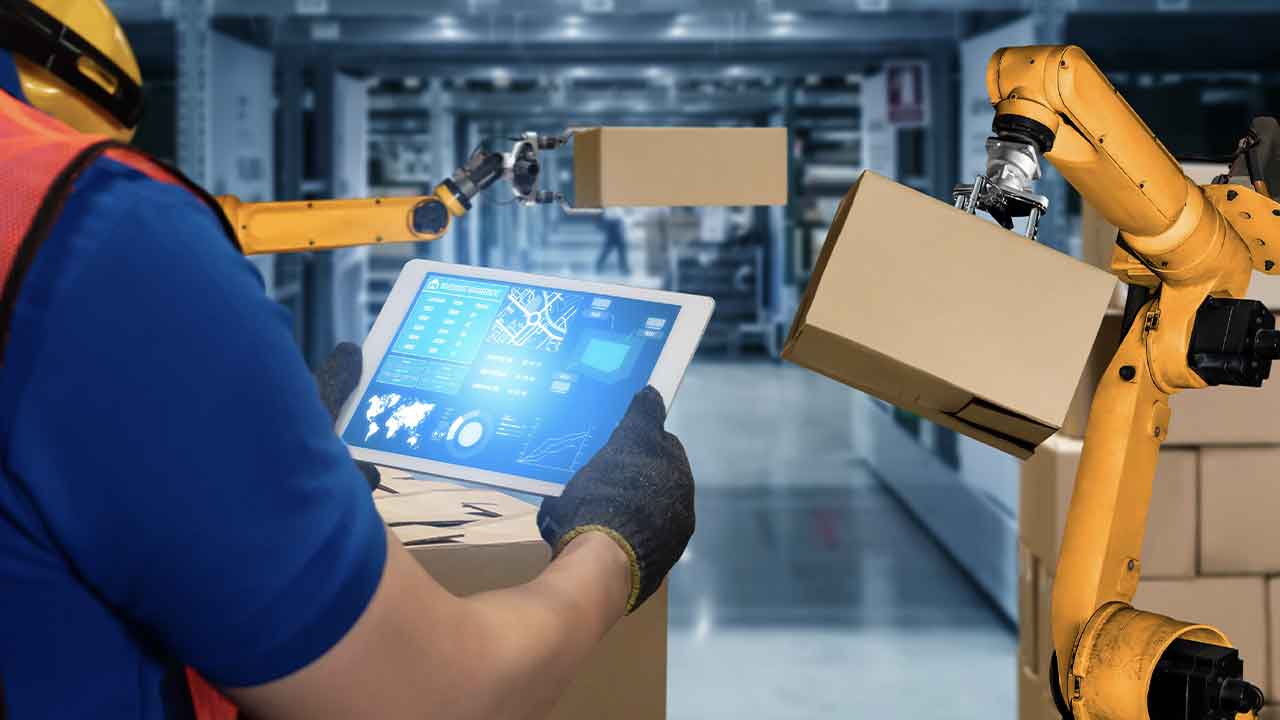Adopting IoT for Manufacturing Sector: Its Impact and Applications
McKinsey’s Global Institute predicts that IoT will have an economic impact of around $11 trillion by the end of 2025. The growing demand for automation, centralized monitoring, and predictive maintenance are leading the IoT technology most prominently in the manufacturing industry.
With issues like abrupt outbreaks, disasters, and conflicts, manufacturers are increasing their search towards the Industrial Internet of Things (IIoT). By integrating IIoT, they plan to stay competitive and strategize better for business growth. Let’s learn the importance of IIoT in the manufacturing sector and its benefits.
What is IIoT Manufacturing?
IIoT – Industrial Internet of Things, is a sub-category of the Internet of Things (IoT). It uses a data-driven approach to drive efficiency into the manufacturing industries. It is a unique concept that includes embedded sensors, cloud-based data, and interconnected devices to ensure better industrial performance. It leverages wide range of tools for the businesses and applies smart techniques to gain a competitive edge. Integrating IIoT concepts for the manufacturing sector help save time and extra operational costs.
What Benefits does IIoT Bring in manufacturing?
For instance, the motorbike manufacturer firm Harley-Davidson used IoT technology for effective transformation in its manufacturing facility. It helped reduce the overall bike production time from 21 days to just 6 hours. Thus, introducing IIoT to manufacturing promises productivity gains, cost and time savings, and safety improvements. Here are a few benefits of including IIoT with the manufacturing industry:
- Improved Inventory Management
- Supply Chain Visibility
- Enhanced Product Quality Controls
- Real-time insights
- Cost Savings
- Asset Security
Impact of Using IoT in the Manufacturing Sector
Using IoT technology is proving beneficial for the industries. It is transforming the manufacturing sector with its data-driven techniques and bringing a digital revolution across the businesses. For many years, manufacturers have been demanding customization, improved productivity, and operability. With the advent of IIoT, there is an enormous impact on the manufacturing fields more than any other field.
Increased Revenue
With the huge transformation in the manufacturing industry, IoT has enabled advanced features to mitigate all possible industrial queries. Also, it has enabled the manufacturers to experience a massive increase in their revenue. Mostly, the increase in revenue numbers depends on the business production. Integrating IoT-powered solutions will not only increase the production levels but will significantly boost the quality of production thereby impacting the revenue increase. The IoT technology helps monitor the machines in real-time and generates accurate reports for better decisions. This helps in making business strategies better and customer-centric. Thus, IoT lays an impact on increasing the revenue of your manufacturing business.
Asset Interconnectivity
The Internet of Things is the technology that enables connectivity between the things (assets). The manufacturing unit comprises of huge machines and units that require keen monitoring to perform better. For instance, if there happened to be a machine breakdown, the entire plant suffers tremendously and there are high chances of the machines losing their efficiency. IoT bridges the gap between the assets and their performance with the help of sensor devices. These devices extract data to present a clearer picture of the asset’s performance and interconnect the entire plant facility to facilitate instantaneous monitoring. This helps the managers to gain real-time information on the conditions of equipment and make decisions accordingly. More about Connected Manufacturing: What it is and Why it is Important
Improved Supply Chain
IoT can improve supply chain operations at significant levels. You can install a smart IoT solution for real-time monitoring, security, and also apply condition-based monitoring, especially on the cold chain products. With a radical transformation due to IoT, the manufacturing sector can now gain insights on every product and save this information on a cloud platform for later use. IoT is a significant concept that primarily aims to create simplified management in the industrial premises and provides cost-effective automation techniques to improve the supply chain operability.
The positive impacts of IoT in the manufacturing domain are leaving a transformational trail that only increases the potentiality of the sector significantly. You also have unique applications of IoT in manufacturing that contribute to better productivity.
IoT Applications in Manufacturing Sector
Simply, IoT integrated assets provide real-time data information that allows the manufacturers to make informed decisions. The sensor devices provide valuable information regarding machine conditions, which is used for manufacturing analysis and predict better outcomes. More about IIoT vs IoT.
Anticipating the Market
Data plays a crucial role in evaluating the patterns and providing information about the quality of production in a manufacturing facility. It further helps the manufacturers to strategize and anticipate the required changes. These predictions can offer improvements in inventory management, staffing requirements, regulating costs, and any other operational dependency. Thus, with the help of IoT technology, it is easier to predict the requirements and optimize the same to primarily satisfy the customers.
Predictive Maintenance
IoT is a sensor-based technology that extracts data from the assets to gain valuable information about their health and performance. The technology is equipped with advanced analytics to provide actionable insights. These are displayed on an aesthetic dashboard connected through your smart gadget, which provides all the necessary information. This allows predictive maintenance to work as an important aspect in the manufacturing sector.
Asset Monitoring
The manufacturing industry is fully equipped with large machines and connected pipelines. You can easily install IoT-powered solutions like smart asset monitoring to calculate their working efficiency and obtain accurate results. Asset monitoring is one of the most significant applications that enhances the actual potential of the industrial assets. It allows the managers to make fine decisions and take necessary actions to improve productivity.
Digital Twins
The digital twin is a concept that represents an IoT process, equipment, or other industrial assets digitally. It provides an accurate representation of the physical asset, which helps identify the problems and allows the managers to optimize a process before its execution. It is a great concept for the upkeep of the machines that reveals the internal functioning as if it were performing for real. Also, you can easily monitor the inaccessible devices in remote locations such as wind turbines, or pipelines situated under the roads through digital twin concept in manufacturing.
Four Considerations for Manufacturing with the IIoT
With global spending on IIoT expected to reach $745 billion in 2019, industries continue to gear up for Industry 4.0. According to International Data Group (IDC), that number represents an increase of over 15% from 2018, and double-digit growth is expected to continue through 2022. Leading the pack are discrete manufacturers and process manufacturers who are expected to spend $119 billion and $78 billion respectively.
The constantly changing world of the IIoT has yet to settle upon a stable or standardized infrastructure, as both capabilities and service offerings continue to be added. Additionally, those functions of IIoT recognized as core technologies not only continue to advance, they are also beginning to overtake many single purpose platforms such as MES to offer alternatives. M
With this level of disruption, it can be confusing to many and easy to overlook the value and services both current and on the horizon. Here are a few considerations to consider with the Industrial Internet of Things in today’s – and tomorrow’s – manufacturing environments:
1. Analytics Architecture is Opening Doors to New Services
The power of deep and advanced analytics in the IIoT has always been one of its biggest advantages. But as these capabilities improve, new software and services are being rolled out to take full advantage of analytics.
This is true of both shop floor operations as well as maintenance and supply chain. Human-based monitoring and analysis is often undertaken in hours, shifts, days or weeks. But operationally, a connected factory can perform the same monitoring on a minute by minute or second by second basis. This depth of analysis allows operators to address downtime and quality issues quickly and accurately through alarms and Pareto charts for any time period to help mitigate bottlenecks. For most platforms, this analysis extends to setup and changeover times to identify areas for improvement.
For maintenance and OEE, conditions-based monitoring is proving to be a powerful analytical tool to improve quality and reduce maintenance costs, unexpected downtime and part cost. Sensors can record sound, vibration, temperature and other variables and analytics can determine the condition of the part to determine if it is working within optimal condition. Real-time automated OEE reporting and operator and staff dashboards are dynamic and allow staff to adjust in real-time rather than after the fact.
Already, the improvement in analytics architecture has spurred new design iterations to take advantage of the wealth of data gathered by connected equipment. And as analytics advance, the architecture of analytics platforms will continue to allow new service levels for these features as well as new services to be added as well.
2. IIoT Platforms are Beginning to Converge and Overtake Traditional Software Applications
Industrial IoT applications are already capable of integrating with traditional software applications such as ERP, MRP, MES, OEE software and finance software to leverage the power of collected data to improve decision making.
But things may be at a tipping point. IIoT platforms today can already provide asset management, real-time conditions-based monitoring, and utilization reporting for equipment. On the shop floor, fixed and mobile devices with KPI displays, customized dashboards, and notifications allow dynamic reaction to issues in real-time. These platforms use open APIs to expand the versatility to feed directly into the platform’s analytical capabilities.
With such a wide range of opportunity to address manufacturing operations under a single system, it is only a matter of time before IIoT systems move from being integrated and complementary to other software to being the primary driver. At that point, older software applications would in the least be redundant, and would perhaps be unnecessary as IIoT technology replaces them.
3. Production Efficiency and Mode of Production
All manufacturers place primary emphasis on production efficiency. Through the use of lean methodology in production, Six Sigma and other programs, manufacturers at the end of the last century were able to bring about remarkable improvements in production efficiency. Those relying on IIoT platforms today are no less focused on efficiency to unlock the “hidden factory” capacity that is possible. Studies show that 43.1% of companies rely on platforms to achieve process optimization while another 41.1% use general dashboards and visualization.
Improved manufacturing visibility has been shown to increase production efficiency by as much as 20% in a connected factory. With real-time machine monitoring, predictive notifications and advanced analytics, that visibility is achieved through customizable dashboards in both fixed and portable displays. This allows operators, technicians and managers to have a powerful view of what is happening around them and gives them the capability to be proactive in their decision making.
Manufacturing IIoT platforms are beneficial to any mode of production. In traditional software applications or manual monitoring, the quality of analysis degraded as complexity of product increased. Accurate analysis, when possible, was often time consuming and dated by the time it could be completed. With IIoT platforms, the volume of data collected from sensors, combined with deep analytics in manufacturing, advanced machine algorithms, and AI allow for accurate visibility and actionable information regardless of the complexity of the operation. This is true for all modes of production but especially true for discrete manufacturers who are often tasked with finding efficient means of producing small lots to remain competitive. The use of IIoT platforms allows these manufacturers to identify workflow and process inefficiencies to address.
4. Security Still Foremost on Manufacturer’s Minds
Studies have shown that only one in three companies have undertaken new security technology for their IIoT deployments. This leaves a high number of enterprises at risk. This is especially critical given that experts suggest building security in at the ground level of the IIoT infrastructure in any company.
The issue is complicated further in that many manufacturers do not possess the skills to undertake an overhaul or replacement of their current security. One study has shown that as high as 56% of companies lack the skills to address cybersecurity to fully deploy their company’s IIoT solutions. For those that began their IIoT transformation early on, most consider security of the system as more important than even the scalability of the system as benefits begin to be realized.
The use of Industrial Internet of Things technology has the potential to deliver greater gains in efficiency, cost and profitability than its counterparts such as lean and Six Sigma in the latter part of the 20th Century. Coupled with production floor visibility, conditions-based monitoring and process optimization, manufacturers are already seeing significant benefits. But every producer should be aware that Industrial IoT is still at the beginning. With each passing month, new advances in computing, improvements to algorithms, gains in AI and sensor and device improvement will continue to open the door for even greater improvements to existing services as well as pave the way for new value-added services and capabilities as well. Find out how Industry 4.0 impacts lean manufacturing.
FAQs about IoT Applications in Manufacturing
How can IoT be used to improve manufacturing productivity?
IoT can improve manufacturing productivity by enabling real-time monitoring of equipment, predictive maintenance, efficient supply chain management, and data-driven decision-making, leading to reduced downtime and increased efficiency.
What are the applications of IoT in the manufacturing industry?
Applications of IoT in manufacturing include predictive maintenance, quality control, supply chain optimization, asset tracking, and smart manufacturing processes that leverage data from connected devices to enhance overall efficiency.
What are the five industries that can benefit from IoT?
Five industries that can benefit from IoT are manufacturing, healthcare, agriculture, transportation, and energy. These sectors leverage IoT for increased automation, data-driven insights, and improved operational efficiency.
What is a real-life example of IoT in manufacturing?
A real-life example of IoT in manufacturing is the use of sensors on production equipment to monitor performance and detect anomalies. This data is then analyzed in real-time to predict maintenance needs, reducing downtime and optimizing production processes.
About the Author
![]() This article was written by Sanjeev Verma, the founder and CEO of Biz4Group, based out of Orlando. He has conceptualized the idea of Biz4 Brand and founded Biz4Group and Biz4Intellia. He has 20+ years of experience in boosting IT-based start-ups to success. In the past, he has worked on leadership positions with Marriott Vacations, Disney, MasterCard, Statefarm, and Oracle.
This article was written by Sanjeev Verma, the founder and CEO of Biz4Group, based out of Orlando. He has conceptualized the idea of Biz4 Brand and founded Biz4Group and Biz4Intellia. He has 20+ years of experience in boosting IT-based start-ups to success. In the past, he has worked on leadership positions with Marriott Vacations, Disney, MasterCard, Statefarm, and Oracle.



